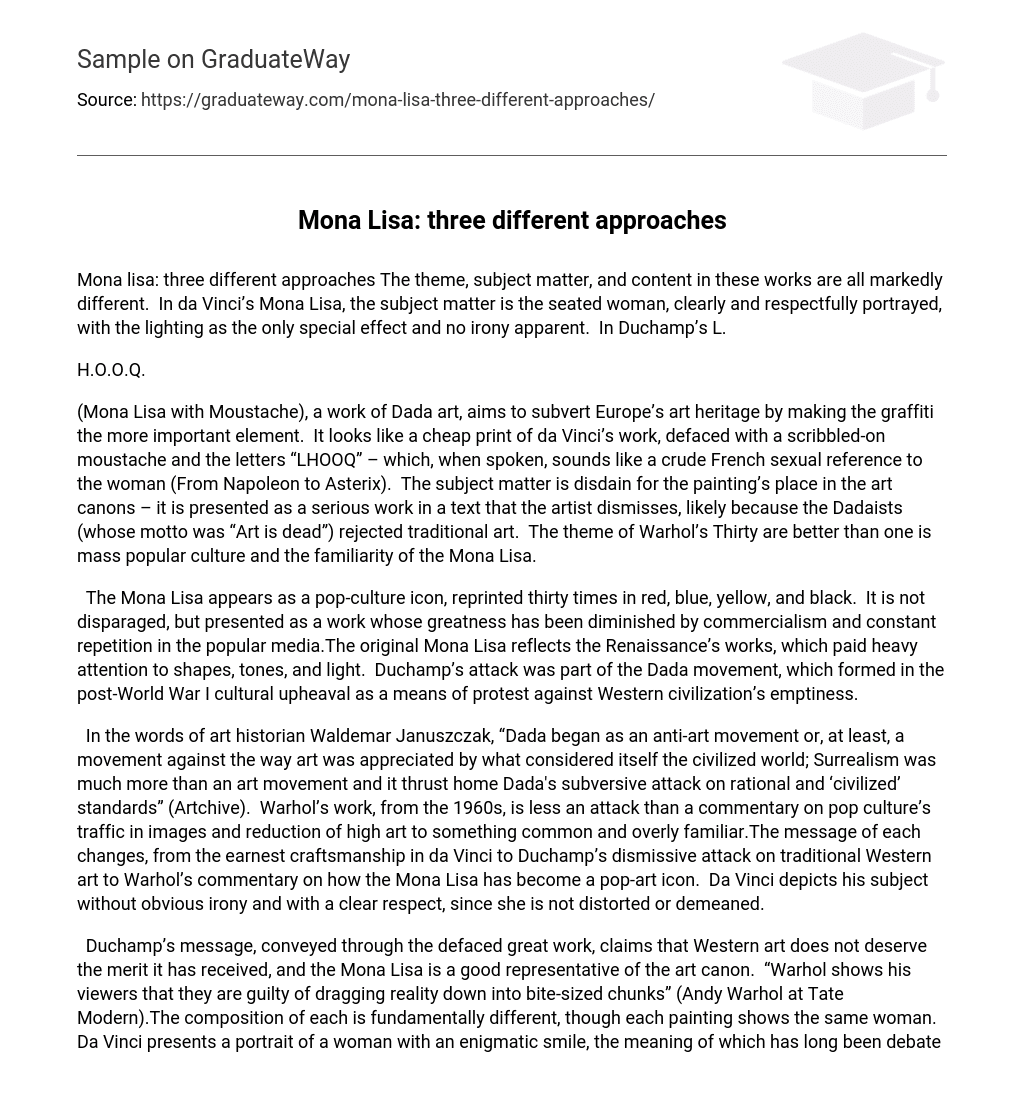Mona lisa: three different approaches The theme, subject matter, and content in these works are all markedly different. In da Vinci’s Mona Lisa, the subject matter is the seated woman, clearly and respectfully portrayed, with the lighting as the only special effect and no irony apparent. In Duchamp’s L.
H.O.O.Q.
(Mona Lisa with Moustache), a work of Dada art, aims to subvert Europe’s art heritage by making the graffiti the more important element. It looks like a cheap print of da Vinci’s work, defaced with a scribbled-on moustache and the letters “LHOOQ” – which, when spoken, sounds like a crude French sexual reference to the woman (From Napoleon to Asterix). The subject matter is disdain for the painting’s place in the art canons – it is presented as a serious work in a text that the artist dismisses, likely because the Dadaists (whose motto was “Art is dead”) rejected traditional art. The theme of Warhol’s Thirty are better than one is mass popular culture and the familiarity of the Mona Lisa.
The Mona Lisa appears as a pop-culture icon, reprinted thirty times in red, blue, yellow, and black. It is not disparaged, but presented as a work whose greatness has been diminished by commercialism and constant repetition in the popular media.The original Mona Lisa reflects the Renaissance’s works, which paid heavy attention to shapes, tones, and light. Duchamp’s attack was part of the Dada movement, which formed in the post-World War I cultural upheaval as a means of protest against Western civilization’s emptiness.
In the words of art historian Waldemar Januszczak, “Dada began as an anti-art movement or, at least, a movement against the way art was appreciated by what considered itself the civilized world; Surrealism was much more than an art movement and it thrust home Dada’s subversive attack on rational and ‘civilized’ standards” (Artchive). Warhol’s work, from the 1960s, is less an attack than a commentary on pop culture’s traffic in images and reduction of high art to something common and overly familiar.The message of each changes, from the earnest craftsmanship in da Vinci to Duchamp’s dismissive attack on traditional Western art to Warhol’s commentary on how the Mona Lisa has become a pop-art icon. Da Vinci depicts his subject without obvious irony and with a clear respect, since she is not distorted or demeaned.
Duchamp’s message, conveyed through the defaced great work, claims that Western art does not deserve the merit it has received, and the Mona Lisa is a good representative of the art canon. “Warhol shows his viewers that they are guilty of dragging reality down into bite-sized chunks” (Andy Warhol at Tate Modern).The composition of each is fundamentally different, though each painting shows the same woman. Da Vinci presents a portrait of a woman with an enigmatic smile, the meaning of which has long been debated.
Duchamp’s work treats the smiling figure as an object on a page, placing it in a different context by making it an object of derision. Warhol treats the figure as part of a collage, repeating it thirty times on the canvas to emphasize its mass reproduction and contemporary status as an icon familiar in popular culture.Duchamp’s Mona Lisa certainly ridicules the original by showing it as a defaced object on a wall or in a book, and by extension he ridicules art in general. By attacking one of Western civilization’s most recognizable and revered objects, Duchamp basically ridicules the whole institution.
Warhol does not ridicule da Vinci’s work, but, when taken in context with his paintings of soup cans and Marilyn Monroe, he comments on how the famous Renaissance work has since become a cultural icon, a commodity reproduced constantly. He seems to pay it a backhanded compliment by acknowledging its fame but also clearly sees it as somehow reduced in stature. In the words of art historian Sister Wendy Beckett, the Mona Lisa “has the innocent disadvantage of being too famous” and “speaks eloquently about the condition of image overload in a media saturated culture” (Artchive).SOURCES;;Harden, Mark.
Mark Harden’s Artchive. 31 August 2005. ;http://artchive.com;.
;;O’Neill-Karch, Mariel and Henriette Gezundhajt. From Napoleon to Asterix. 2000. Department of French Studies, University of Toronto.
31 August 2005. ;http://french.chass.utoronto.
ca/fcs195/;.;;Penn, Steve. “Andy Warhol at Tate Modern.” The Mighty Organ.
31 August 2005. ;http://www.themightyorgan.com/reviews_warhol.html;.





